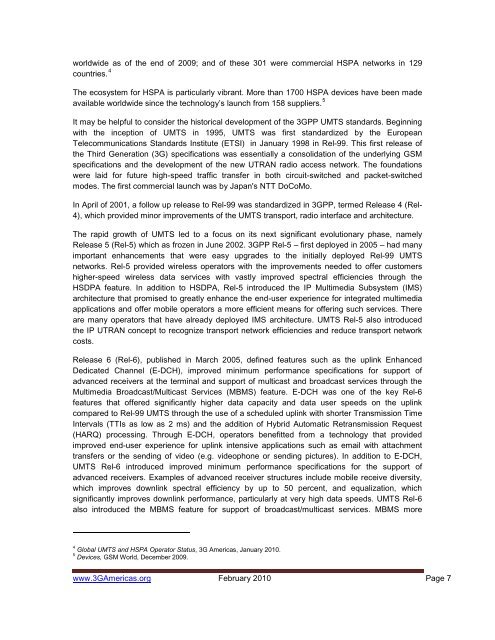UMTS: Alive and Well - 4G Americas
UMTS: Alive and Well - 4G Americas
UMTS: Alive and Well - 4G Americas
You also want an ePaper? Increase the reach of your titles
YUMPU automatically turns print PDFs into web optimized ePapers that Google loves.
worldwide as of the end of 2009; <strong>and</strong> of these 301 were commercial HSPA networks in 129countries. 4The ecosystem for HSPA is particularly vibrant. More than 1700 HSPA devices have been madeavailable worldwide since the technology’s launch from 158 suppliers. 5It may be helpful to consider the historical development of the 3GPP <strong>UMTS</strong> st<strong>and</strong>ards. Beginningwith the inception of <strong>UMTS</strong> in 1995, <strong>UMTS</strong> was first st<strong>and</strong>ardized by the EuropeanTelecommunications St<strong>and</strong>ards Institute (ETSI) in January 1998 in Rel-99. This first release ofthe Third Generation (3G) specifications was essentially a consolidation of the underlying GSMspecifications <strong>and</strong> the development of the new UTRAN radio access network. The foundationswere laid for future high-speed traffic transfer in both circuit-switched <strong>and</strong> packet-switchedmodes. The first commercial launch was by Japan's NTT DoCoMo.In April of 2001, a follow up release to Rel-99 was st<strong>and</strong>ardized in 3GPP, termed Release 4 (Rel-4), which provided minor improvements of the <strong>UMTS</strong> transport, radio interface <strong>and</strong> architecture.The rapid growth of <strong>UMTS</strong> led to a focus on its next significant evolutionary phase, namelyRelease 5 (Rel-5) which as frozen in June 2002. 3GPP Rel-5 – first deployed in 2005 – had manyimportant enhancements that were easy upgrades to the initially deployed Rel-99 <strong>UMTS</strong>networks. Rel-5 provided wireless operators with the improvements needed to offer customershigher-speed wireless data services with vastly improved spectral efficiencies through theHSDPA feature. In addition to HSDPA, Rel-5 introduced the IP Multimedia Subsystem (IMS)architecture that promised to greatly enhance the end-user experience for integrated multimediaapplications <strong>and</strong> offer mobile operators a more efficient means for offering such services. Thereare many operators that have already deployed IMS architecture. <strong>UMTS</strong> Rel-5 also introducedthe IP UTRAN concept to recognize transport network efficiencies <strong>and</strong> reduce transport networkcosts.Release 6 (Rel-6), published in March 2005, defined features such as the uplink EnhancedDedicated Channel (E-DCH), improved minimum performance specifications for support ofadvanced receivers at the terminal <strong>and</strong> support of multicast <strong>and</strong> broadcast services through theMultimedia Broadcast/Multicast Services (MBMS) feature. E-DCH was one of the key Rel-6features that offered significantly higher data capacity <strong>and</strong> data user speeds on the uplinkcompared to Rel-99 <strong>UMTS</strong> through the use of a scheduled uplink with shorter Transmission TimeIntervals (TTIs as low as 2 ms) <strong>and</strong> the addition of Hybrid Automatic Retransmission Request(HARQ) processing. Through E-DCH, operators benefitted from a technology that providedimproved end-user experience for uplink intensive applications such as email with attachmenttransfers or the sending of video (e.g. videophone or sending pictures). In addition to E-DCH,<strong>UMTS</strong> Rel-6 introduced improved minimum performance specifications for the support ofadvanced receivers. Examples of advanced receiver structures include mobile receive diversity,which improves downlink spectral efficiency by up to 50 percent, <strong>and</strong> equalization, whichsignificantly improves downlink performance, particularly at very high data speeds. <strong>UMTS</strong> Rel-6also introduced the MBMS feature for support of broadcast/multicast services. MBMS more4 Global <strong>UMTS</strong> <strong>and</strong> HSPA Operator Status, 3G <strong>Americas</strong>, January 2010.5 Devices, GSM World, December 2009.www.3G<strong>Americas</strong>.org February 2010 Page 7
















